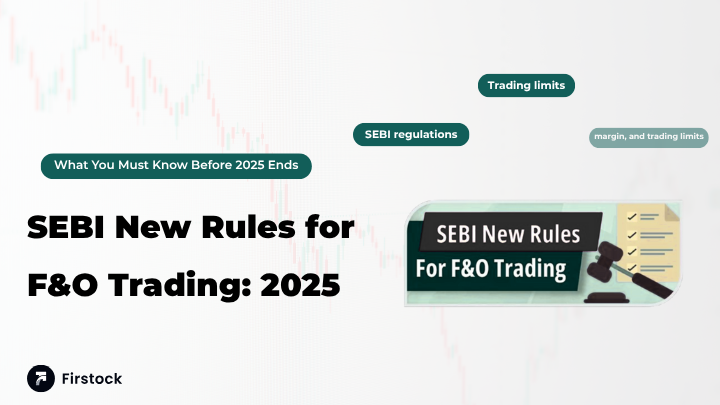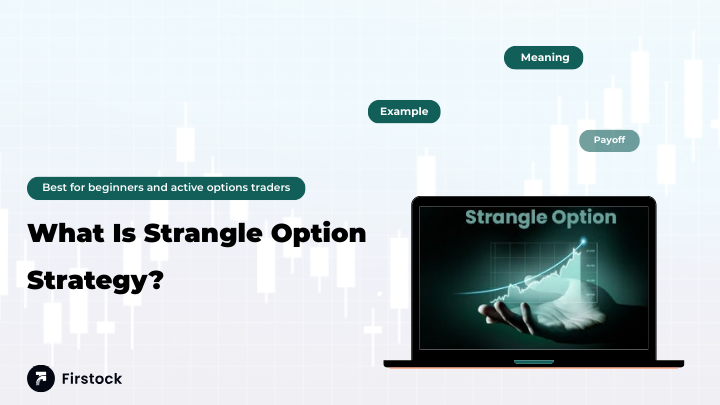Must-Read: SEBI New Rules for F&O Trading in 2025

SEBI New Rules for F&O Trading: What You Must Know Before 2025 Ends
Have you heard about the wave of changes sweeping the futures & options (F&O) world in India? The regulator, SEBI, has shaken up the trading landscape with its sebi new rules for f&o trading, and whether you’re a seasoned trader or a curious beginner you’ll want to sit up and take notice. These aren’t just tweaks — they’re meaningful shifts in how derivatives are handled. And as you adapt, you’ll want a reliable trading platform like Firstock by your side.
Consider trading F&O like driving on a busy highway: until now, you could speed, change lanes freely, and sometimes cut corners. But SEBI is now installing speed-cameras, lane-assist and stricter checkpoints. You’ll still drive, but you’ll have to obey new rules and stay alert.
Here’s the roadmap for the article: we’ll dive into the new SEBI rules for F&O, why they matter, how they impact you, and how a broker like Firstock can make your journey smoother.
Understanding F&O Trading & Why SEBI Stepped In
Before getting into the details of the new F&O rules, let’s make sure we’re on the same page about what F&O trading is. In simple words, Futures & Options are contracts giving you exposure to stocks or indices without owning them outright. You can speculate, hedge or take leveraged positions. That’s great… until things get risky or skewed.
SEBI stepped in because the F&O market had grown enormously, volumes were booming, exposure was huge, and risks were accumulating — not just for individual traders, but for the market as a whole. SEBI was of the view that it needed greater transparency, better risk management and reduced speculation.
Imagine that it is as follows: you and your friends are driving autos on narrow lanes at the time of peak hour. There are drivers hogging, taking enormous risks, and making it very close to accidents. The regulator is now stepping in to widen lanes, set stricter rules and install cameras so everyone drives more responsibly.
Key Changes: What the “New SEBI Rules for F&O” Cover
With the big picture set, here are the major buckets where the new SEBI rules for F&O make a difference:
- MWPL linked to free float and cash market volume.
- Entity‐level limits for individuals, brokers, proprietaries.
- Intraday monitoring and expiry day special rules.
- New risk metrics and open interest measurement.
- Amendments to eligibility criteria for F&O contracts and underlying stocks.
So yes, the changes are quite broad: from how many contracts you can hold, to how brokers monitor positions, to how the system recognises risk. Let’s break them down.
Market-Wide Position Limit (MWPL): The Big Shift
One of the biggest changes under the sebi new rules for f&o trading is the way the market-wide position limit (MWPL) is determined and enforced.
- The new MWPL will now be the lower of either 15 % of free-float of the stock or 65 times the average daily cash delivery volume ( ADDV).
- For example: if a stock has large free-float and big cash market volume, MWPL will be higher; if either is low, MWPL will shrink accordingly.
- Important effect: If open interest in the derivatives for a stock exceeds 95% of MWPL, brokers/traders can only reduce positions (no fresh increase) for that stock.
In simpler terms: The regulator is saying “you can’t flood one stock’s F&O with wild contracts if the cash market is small.” It’s like saying you can’t fill a small bucket with too many stones because it’ll overflow.
Entity-level Position Limits for Single Stock Derivatives
Next big change: the new SEBI rules for F&O set fresh limits for each entity (individual trader, prop broker, brokerage firm) on single stock derivatives.
- For individuals: capped at 10% of MWPL.
- For proprietary brokers: capped at 20% of MWPL.
- For overall brokers & Foreign Portfolio Investors (FPIs): capped at 30% of MWPL.
This means if the MWPL for a stock is, say, 100 units, an individual’s exposure in that stock’s derivatives cannot exceed 10 units (in equivalent exposure) under these rules.
Why this matters: It prevents any one individual or firm from building a dangerously large position in a single stock derivative, which could lead to market manipulation or cascade‐risk.
Intraday Monitoring & Expiry Day Rules
The new F&O rules also bring changes around monitoring intraday positions and the special quirks of expiry day trading.
- Exchanges will take multiple random snapshots during the trading session to monitor gross/ net positions in index derivatives.
- On contract expiry day (for index derivatives), penalties or surveillance deposits apply if limits are breached.
- Some margin benefits (like calendar spreads or hedged positions) are already curtailed by earlier rules.
What this means for a trader: you can’t rely on “I’ll fix it by end of day” as easily as earlier. The system is actively watching your moves throughout the day, especially when you’re dealing with high-risk expiry scenarios.
Risk Metrics & Open Interest Reporting Changes
Under the banner of “new SEBI rules for F&O”, SEBI has changed how it measures risk and how it expects participants to report positions and open interest.
- Previously, open interest (OI) was largely measured end-of-day. Now SEBI wants measures that reflect real exposure relative to cash market movements.
- The idea: Track the “delta” and real exposure of derivative contracts (not just number of contracts).
- Eligibility criteria for underlying stocks to be part of F&O have also been tightened (e.g., index composition rule: at least 80% of the index must comprise stocks individually eligible for derivatives).
In analogy: Think of it as shifting from checking only how many cars are parked (contracts) to checking how much weight those cars carry and how fast they may accelerate (exposure & risk).
Impact on Retail Traders: What You Must Adjust
Now let’s bring this into your world, especially if you’re trading or planning to trade F&O using a platform like Firstock. The new SEBI rules for F&O affect you in these ways:
- Reduced leverage or capacity: With tighter exposure limits, you might find your maximum permissible position in a given stock derivative is lower than before.
- Need for better planning: You’ll have to think in terms of exposure relative to cash market; hedging and spreads may not give same benefits as earlier.
- Platform selection matters: To trade efficiently under these rules you need a broker that offers real-time monitoring, exposure checks, margin alerts – that’s where Firstock shines.
- Risk awareness goes up: If you trade without understanding how the rules work, you may face margin calls, penalties or forced reductions.
- Expiry day caution: Big moves on expiry days carry heightened scrutiny under the new framework.
So if you were trading like a wild stallion, now you need to ride more like a well-trained pony with steering, brakes and a plan.
How a Platform like Firstock Helps Navigate These Rules
Since we’re discussing the new SEBI rules for F&O, it makes sense to talk about how a broker can support you. One such app for options trading in india is Firstock. Here’s how it stands out:
- Firstock is a SEBI-registered broker that offers trading in Stocks, F&O, Mutual Funds, IPOs and more.
- It offers transparent and competitive pricing: Zero brokerage on equity delivery, flat fees for F&O orders, etc.
- The platform emphasizes advanced tools: strategy builder, position monitoring, one-click execution of complex strategies – useful when rules are tighter.
- Because rules around monitoring, exposure and risk are stricter, using a platform that gives you margin/limit alerts, exposure snapshot and real-time position checks is very beneficial.
So, if you’re adjusting to the new F&O rules, having a broker like Firstock is like driving that highway in a modern car with lane-assist and speed alerts, rather than an old beater with no gauges.
Practical Tips: Trading Smart under the New F&O Rules
Here are some actionable tips to help you work smart amidst the sebi new rules for f&o trading:
- Keep a check on the underlying cash market volume and free-float of any stock you trade in F&O. Higher liquidity means more room for contracts.
- Avoid building very large single-stock derivative exposures — remember the 10%/20%/30% caps apply.
- Use the tools on your broker (like Firstock) to monitor real-time open interest and exposure, not just contract counts.
- On expiry days, be extra cautious: keep margin comfortable, avoid relying solely on hedges gaining you margin benefits, and avoid large unhedged bets late in the day.
- Have a stop-loss or hedging strategy ready — the rules are tighter, so getting forced out or reduced is a bigger risk.
- Update yourself on the circulars or notifications from SEBI and your broker — rules can evolve further.
Common Mistakes to Avoid in the New Framework
Let’s talk about the mistakes traders often make under the new regime:
- Mistake: Assuming previous exemptions still apply. For example, hedged positions giving margin relief may no longer always hold.
- Mistake: Ignoring cash market context. Traders sometimes treat F&O like isolated bets — but now the cash market matters more.
- Mistake: Not monitoring end-of-day exposure. With intraday snapshots and monitoring, you can't ignore your exposure buildup.
- Mistake: Over-relying on extreme leverage. Even if your broker allows big positions, SEBI caps may bite and you may be forced to reduce positions.
- Mistake: Picking illiquid stocks for single-stock derivatives. Since eligibility criteria have tightened for underlying stocks, risk is higher.
Avoid these and you’ll stand a better chance of navigating the new terrain well.
Looking Ahead: What Might Come Next in F&O Regulation
We’re at a point where the new SEBI rules for F&O have been rolled out, but markets evolve and regulation often follows. What could come next?
- Possibly further tightening or monitoring of algorithmic/ high-frequency derivatives trades, especially if they skew exposure.
- Enhanced transparency around retail vs institutional trades in the F&O market.
- Possibly more stringent suitability or onboarding criteria for new traders entering F&O segments.
- New technology or real-time data requirements for brokers to report exposures and delta positions more accurately.
If you're staying updated via your broker platform (like Firstock) and market news, you’ll be able to adapt faster.
Conclusion
In short: yes, the sebi new rules for f&o trading represent a meaningful change in the game. They are designed to make F&O trading safer, more transparent and more aligned with the underlying cash market. As a trader, you must adapt your strategies, stay alert to exposure limits and use a capable broker platform like Firstock to support you.
Imagine you're on a fast-moving train (F&O trading) and the control room (SEBI) has shifted the speed limits and track configurations. To stay on board safely, you need to reduce speed, change your route plans and rely on a smart conductor (your broker) to guide you.
If you stay informed, follow the rules and pick the right tools, you’ll not just survive the regulatory change — you’ll thrive.
FAQs
1. What exactly are the “new SEBI rules for F&O” about?
They refer to a set of regulations introduced by SEBI governing F&O trading in India – covering market-wide position limits (MWPL), entity-level caps, real-time monitoring, and eligibility criteria.
2. When did these rules take effect?
Many parts came into effect around 1 October 2025, especially MWPL and entity-level position limits for single stock derivatives.
3. How will these rules affect a retail trader like me?
You’ll need to plan your trades more cautiously, monitor your exposure relative to the cash market, possibly take smaller positions, especially in single stock derivatives, and use a broker that gives you good tools for monitoring risk.
4. Why should I consider using Firstock with these changes?
Firstock offers transparent pricing, advanced tools for F&O (strategy builder, analytics, real-time monitoring) and is well suited to help you navigate the new rules. With the regulatory shifts, having a responsive platform can make a difference.
5. Are there more changes on the horizon?
Yes. SEBI has already indicated further work on risk metrics, exposures and possibly suitability criteria for F&O traders. It’s wise to stay updated regularly.





